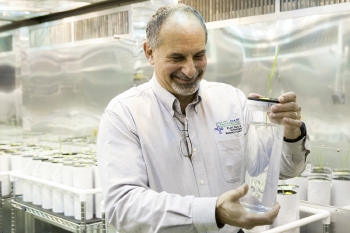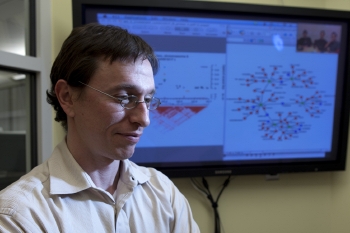COVER STORY
(Page 4 of 6)Genetic variation
There are 22 different species of Oryza, the genus we call rice; and of those, two were independently domesticated, one in Africa (Oryza glaberrima) and one in Asia (Oryza sativa), likely in the Yangtze River Valley, around 10,000 years ago. Early farmers selected the obvious, visible traits they desired, saving seeds from plants with upright stems, quick growth, larger, aromatic, flavorful grains, and seed hulls that didn't shatter for harvesting ease. But once they made such selections, they rarely went back and mixed their domesticated rice with the wild rice to see what other useful traits might be garnered.
As a result, today's cultivars hold a small subset – perhaps around 40 percent for Asian rice – of the variety of genes available in their ancestors.

Plant physiologist and professor Leon Kochian also is director of the USDA's Robert W. Holley Center for Agriculture and Health at Cornell. See larger image
Oryza rufipogon, the wild ancestor of Asian rice that McCouch and her colleagues work with, comes in hundreds of different forms. All are low-yielding with thin, red grain; some types are small and upright; others are eight feet tall and put out horizontal stolons – running stalks that root, break off and send up shoots in vegetative reproduction. Much of the genetic potential, such as the capacity to produce abundant grain yield, has long been hidden. But breeders can now begin to harness those hidden traits, thanks to researchers like McCouch and her colleagues.
Power of collaboration
Based on two National Science Foundation grants (one for $6 million, the other for $6.9 million), McCouch is seeking to provide a research prototype that others can build on. The research entails developing genomic datasets and analysis tools to determine genetic variation at the DNA level in hundreds of thousands of diverse rice strains and wild ancestors, then using the information to identify genes of interest, understand what traits they confer, how they behave when crossed with cultivars, and to make this information available on a Web database for rice researchers and breeders around the world. The project will also provide purified seed stocks and novel collections of lines with specific wild genes bred into them, to expand the use of wild and exotic materials in fundamental research and for breeding new varieties.

Computational biologist Jason Mezey is an assistant professor with an appointment in biological statistics and computational biology at Cornell in Ithaca and in genetic medicine at Weill Cornell Medical College in New York City. See larger image
None of this work would even be possible without the help of gene banks and public agencies that collect, characterize and distribute seeds of cultivated varieties and strains of wild exotic rice. Among them are the U.S. Department of Agriculture (USDA) and the International Rice Research Institute in the Philippines – where Cornell has had strong ties since the institute's founding 50 years ago and where McCouch herself worked for four years after completing her Cornell Ph.D. in 1990. The West Africa Rice Development Association and Centro Internacional de Agricultura Tropical in Colombia also manage, use and distribute genetic resources to the public.
These institutions are all longtime collaborators, helping to test and disseminate Cornell prototypes of technology, pre-breeding varieties and knowledge to local breeders. Researchers in Japan, China, India, Indonesia and Taiwan have also worked closely with McCouch to grow out and measure observable characteristics, called phenotyping, of existing varieties and breeding populations.
<<View entire story as one page>>